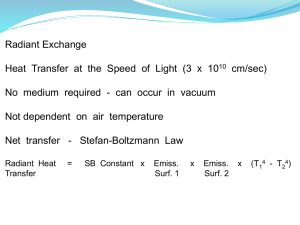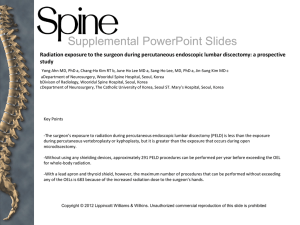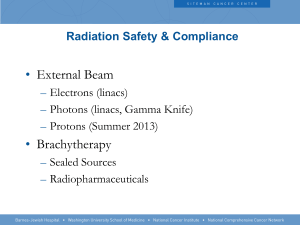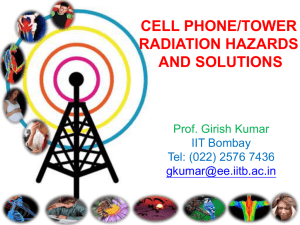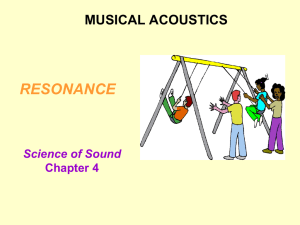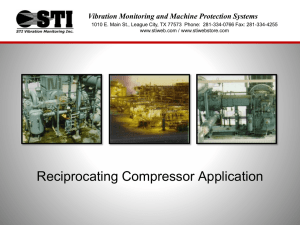Physical Hazards
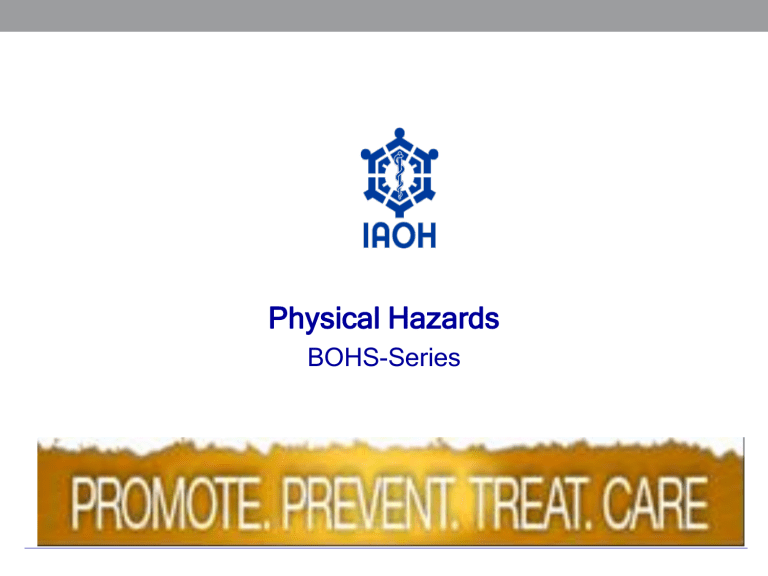
Physical Hazards
BOHS-Series
IAOH - 2013
What is a hazard?
2
IAOH - 2013
Hazard = Anything with a POTENTIAL to cause harm
3
IAOH - 2013
Hazard
Potential of an agent to cause harm
4
IAOH - 2013
Exposure
Contact with a Hazard is called Exposure
Exposure is a combination of
Magnitude
Frequency
Duration
5
IAOH - 2013
Risk
Likelihood that an agent will cause harm in the actual circumstances of exposure
RISK occurs only when there is
6
Hazard
Exposure
IAOH - 2013
Health Risk = Hazard x Exposure
Exposure
7
Hazard
IAOH - 2013
Health Risk
No Hazard = No Risk
Hazard, but no Exposure = No Risk
Health Risk = Hazard x Exposure
8
IAOH - 2013
Heat Stress
How Hot We Feel
Playing sports like soccer on a hot summer day makes you feel hot.
When you work harder, you feel hotter. When you stop to take a rest, even though you are still in the same hot environment, you feel cooler.
How hot we feel depends on:
1) air temperature – measured with a normal thermometer, this is the temperature of the air around us. Although it is the easiest factor to measure, it is actually the least important under hot conditions.
2) humidity – this is the amount of water in the air. Under hot conditions, people feel even hotter when the air is more humid than when it is drier.
Although a person will sweat, the sweat will not evaporate as quickly if the air is filled with moisture. Less evaporation means less cooling.
9
IAOH - 2013
3) radiant heat – this is heat given off by anything that is hot, such as the sun, molten metal, hot pipes or a heater. It eventually heats the air, but it heats people more quickly. Radiant heat affects a person working in sunlight or near a work process that radiates heat. By simply moving from sun to shade, a person can feel the difference that radiant heat makes.
4) air speed – also known as wind speed. Moving air that is cooler than the skin cools a person.
5) physical activity – body temperature increases with physical activity. Under warm or hot conditions, physical activity can increase the effect of heat on a person.
6) clothing – clothing can help or hinder. It can shield you from radiant heat, prevent sweat from evaporating or help to transfer heat. Some protective clothing is not appropriate under hot conditions and can pose a problem; e.g., chemical suit that does not allow air or moisture to pass through it.
Other factors that may affect a person’s ability to work in the heat include his or her age, health status, level of fitness, body weight, level of hydration and use of prescription and nonprescription drugs.
10
IAOH - 2013
How Does Heat Affect the Body?
The human body works at its best within a narrow temperature range.
Move 2°C or more above or below the body’s normal temperature of 37°C and problems can start to happen. 37°C is the body’s core temperature – the temperature of the brain, heart and other organs. Skin temperature may differ from core temperature by a few degrees.
The body controls its core temperature in a few ways. Sweating lowers the temperature and shivering raises it. Increasing blood flow to the skin helps remove heat and reducing the flow of blood helps conserve heat.
As a person works in a hot environment, his or her core temperature rises. To keep cool, the body sweats. The sweat then evaporates and cools the body. If the fluid lost as sweat is not replaced, the person becomes dehydrated and unable to sweat. The body then loses its ability to control its core temperature and serious heat problems can result.
11
IAOH - 2013
Acclimatization
The human body can adapt to hot conditions and work safely and comfortably. This is known as acclimatization. Depending on the person, acclimatization may take about four to seven days of working in hot conditions. Full heat adaptation takes up to three weeks of continued physical activity under hot conditions. Physically fit workers make this adjustment faster than unfit workers. Acclimatization is lost quickly – one week away from the hot conditions and a person loses his or her adaptation to the heat. A small percentage of people are unable to acclimatize at all.
Heat stress happens when hot working conditions start to harm a worker..
12
IAOH - 2013
Heat stress can be of 2 types:
not life threatening – including conditions, such as dehydration and heat exhaustion
life threatening – heat stroke, a condition during which the body is unable to regulate its temperature
13
IAOH - 2013
Heat Stress Conditions and Their Symptoms
Heat rash (prickly heat)
tingling and burning of the skin, red itchy rash
sweat glands plugged due to prolonged exposure of skin to heat, humidity and sweat
Heat cramps
painful spasms of muscles that do the hardest work; i.e., in the arms, legs and abdomen
14
IAOH - 2013 15
IAOH - 2013
Fainting
increased flow of blood to the skin to get rid of heat means less blood to the brain
Heat exhaustion
tired, weak, dizzy, clammy skin and slow weak pulse
pale or flushed skin colour
higher than normal heart rate (i.e., 160 to 180 beats/min)
Heat stroke
person usually stops sweating, body core temperature is high (40° –
43°C), skin is hot and dry
headache, dizziness, confusion, may lose consciousness or have fits
fatal if treatment is delayed – this is a medical emergency!
16
IAOH - 2013
Who are susceptible?
Workers exposed to:
High temperature and humidity e.g., from a kitchen or laundry
Radiant heat sources e.g., from a dryer, oven, furnace or molten metal
Contact with hot objects
Direct sun exposure (with no shade)
Limited air movement (no breeze, wind or ventilation)
Physical exertion
Use of bulky or non-breathable protective clothing and equipment
17
IAOH - 2013
How do I know if it's too hot?
The temperature rises
Humidity increases
The sun gets stronger
There is no air movement
No controls are in place to reduce the impacts of equipment that radiates heat
Protective clothing or gear is worn
Work is strenuous
18
IAOH - 2013
What Can You Do to Protect Yourself?
Drink plenty of water (e.g., one cup every 20 minutes), even if you do not feel thirsty.
Wear loose clothes in light colours. (Technical fibres that wick away sweat and allow it to evaporate are preferred.)
Take frequent rests in shaded areas, if possible; do not over-exert.
Acclimatize yourself slowly to hot weather.
19
IAOH - 2013
Jobs in which Cold May Be an Occupational
Hazard
outdoor work, including: road building and other construction work
electrical and telecommunications linemen
police officers, fire fighters, emergency response workers, military personnel
transport workers, bus and truck drivers
fishers, hunters and trappers
divers
outdoor recreation workers (e.g., ski lift operators)
work in refrigerated warehouses
meat packaging and meat storage
20
IAOH - 2013
How Can Cold Stress Affect You?
As temperature decreases and the duration of exposure increases, the following changes can be experienced:
reduced dexterity of the hands and feet
reduced tactile sensation
impaired ability to perceive heat, cold and pain
reduced joint mobility
reduced grip strength
hypothermia; e.g., reduced body temperature, which, in its extreme form, can result in death
frostbite – frozen tissue or frostnip – very mild, superficial freezing of exposed skin
reduced coordination
reduced decision-making ability
21
IAOH - 2013
To prevent cold stress:
dress warmly
drink warm fluids
take regular breaks in a warm shelter
move immediately to a warm shelter if excessive shivering starts
Note that the clothing worn to maintain comfort in the cold can limit performance:
Hats and hoods may interfere with hearing, vision and movement.
Bulky clothing layers may restrict movement.
Gloves, mittens and overmitts may reduce dexterity and tactile feel.
Footwear may be heavy and bulky, compromising the ability to use footholds and vehicle foot pedals.
The weight and bulk of clothing increases the amount of effort required when moving.
22
IAOH - 2013
What is noise ?
A philosophical question:
Did the ‘Big Bang’ produce noise ?
23
IAOH - 2013
Answer is NO
Since by definition, noise is ‘unwanted’ sound and is therefore a subjective perception.
However, for us ( concerned with OSH), noise is any sound that can cause a problem: acute / chronic
24
IAOH - 2013
Some basics…
Frequency of the sound determines the pitch (Hz)
Intensity leads to perception of loudness (dB)
Frequency range audible to human ear is 20-20000 Hz
Sounds below and above this range are called infra and ultra sound
25
IAOH - 2013
Some dB levels
Rustle of a leaf
( threshold of hearing) : 0 dB
Background in TV studio: 20 dB
Quiet bedroom:
30dB
Conversation: 60 dB
26
IAOH - 2013
dBs contd…
Kerbside of a busy road: 80 dB
Disco: 100 dB
Chainsaw: 110 dB
Threshold of pain:
130 dB
30 m from jet aircraft: 140 dB
27
IAOH - 2013 28
IAOH - 2013
Some complications..
dBA or the ‘A weighted’ scale measures sound as would be heard by human ears ( since human ear is not equally sensitive to all frequencies)
dB is a logarithmic scale
‘0’ dB is not absolute zero, but the lowest intensity audible to normal human ear
Above 140 may cause instant damage even if it is not a continuous noise
29
IAOH - 2013
Wheels within wheels..
When there are two adjacent machines producing 90 dB noise, what will be the resultant noise?
We can notice an increase in intensity of sound if it goes up by 3dB. The sound energy / pressure is doubled (relevance of Factories Act) due to this.
An ‘appreciable’ increment may be actually a 10 dB difference
30
IAOH - 2013
Addition of decibels
5
8
10
1
2
Difference between dB levels
0
Amount to be added to higher level
3.0
2.5
2.1
1.2
0.6
0.4
31
IAOH - 2013
And now.. Some music to ears..
Difference between noise and music
Pure tone
Harmonics
Bass
Treble
White noise
32
IAOH - 2013 33
IAOH - 2013 34
IAOH - 2013 35
IAOH - 2013
From Physics to Anatomy & Physiology…
Unlike other senses, hearing is mainly a ‘mechanical’ perception
It involves reception, transmission, amplification of sound waves AND production of nerve impulses in inner ear.
These impulses are interpreted as different sounds by the brain
36
IAOH - 2013 37
IAOH - 2013 38
IAOH - 2013 39
IAOH - 2013 40
IAOH - 2013 41
IAOH - 2013 42
IAOH - 2013
To summarize the basics…
An object produces sound when it vibrates in matter. This could be a solid, such as earth; a liquid, such as water; or a gas, such as air. Most of the time, we hear sounds traveling through the air in our atmosphere.
To hear sound, ear has to do three basic things:
Direct the sound waves into the hearing part of the ear
Sense the fluctuations in air pressure
Translate these fluctuations into an electrical signal that brain can understand
43
IAOH - 2013 44
Higher pitches vibrate the basilar membrane most intensely near the oval window, and lower pitches vibrate the basilar membrane most intensely at a point farther down the cochlea. ( probably the reason why higher frequencies are affected first in NIHL).
The cochlea (inner ear) only sends raw data -- complex patterns of electrical impulses. The brain is like a central computer, taking this input and making some sense of it all. This is an extraordinarily complex operation.
IAOH - 2013
Measurement of noise & exposure
SLM (Sound level meters)
Dosimeter
Frequency analysis
( Octave band analysis)
45
IAOH - 2013
Why HCP
NIHL is characterized by 4 'P's
1. Painless
2. Progressive
3. Permanent
4. Preventable
46
IAOH - 2013
Although no physical pain with NIHL,
Life without one of the main senses will certainly be painful
Hence HCP (? Health Conscious People)
TTS: Temporary threshold shift
PTS: Permanent threshold shift
Vital to detect TTS while damage not yet permanent.
Hence do audiometry both post & pre shift.
47
IAOH - 2013
Components
1. Commitment
2. Commitment
3. Commitment
4. Buy in ( mainly red & orange zone)
5. Mapping, dosimetry
6. Engineering
7. Administrative
8. HPDs
09. Audiometry (annual)
10. Counseling
11. Training
12. Training
48
IAOH - 2013
Vibration Exposure to Hands and Arms
Short-term exposure to vibration may cause tingling and numbness or damage to blood vessels in fingers and hands. Long-term exposure to hand-arm vibration damages the blood vessels and nerves in the fingers and hands. Damage is especially painful when hands are cold. In severe cases, the person may lose some of the use of his or her hands. This condition used to be called hand-arm vibration syndrome (HAVS), raynauds syndrome or white finger disease.
49
IAOH - 2013
Whole Body Vibration Exposure
Whole body vibration may cause neck injuries, damage to lower back and joints or cause fatigue, insomnia, headaches or shakiness during or shortly after exposure. Many years of exposure to whole body vibration can affect the entire body and result in a number of health disorders.
Riding in a car or truck on a gravel road or taking some amusement rides may expose you to lower back and neck injury. Working in plants with motors, compressors or engines can expose a worker to significant vibration hazards.
50
IAOH - 2013
How is Exposure to Vibration Prevented?
The best way to prevent vibration exposure is to buy tools and equipment that produce as little vibration as possible. Such tools and equipment have controls built in to prevent harmful vibration exposure.
Heavy machines and equipment have vibration isolation mounting that stops machine vibration from affecting the attached structures. For example, many buses have driver seats with vibration isolation mounting.
Spring and shock absorbers in your car are types of vibration isolation.
When these vibration isolators are defective, a car ride can be a source of vibration exposure.
51
IAOH - 2013
Generally, to prevent exposure, workers should:
limit the amount of time vibrating tools are used
take a 10-minute break for every hour spent working with a vibrating tool
alternate between vibrating and nonvibrating tools
let the tool do the work and use as light a grip as possible
service and maintain the tools in good working condition
NOTE: There isn’t any proven Personal Protective Equipment that workers can wear to prevent exposure to vibration.
52
IAOH - 2013
Radiation
Radiation is energy that is emitted through space or matter. Some types of radiation travel as waves and others as particles. When we switch on a light bulb, light comes to us as radiation. When the sun rises, we feel warm because the sun radiates energy in the form of light and heat.
Radiation does not need a medium in which to travel. If you place an oldfashioned alarm clock in a jar and evacuate the jar, using a vacuum pump, you will not hear the alarm because sound needs air as a medium to travel. You will still see the radium dial in the dark because light does not need a medium.
Radiation is divided into two categories:
ionizing radiation
non-ionizing radiation
53
IAOH - 2013
Ionizing radiation is high energy electromagnetic radiation that is able to disrupt the structure of atoms or molecules. It is given off by X-ray machines and radioactive materials, such as plutonium. Some amount of background ionizing radiation is present everywhere. It comes from the earth and outer space.
Non-ionizing radiation does not have enough energy to disrupt the structure of atoms or molecules. Examples of non-ionizing radiation include radiation from the sun, light, electric power lines, radio and TV antenna, lasers, industrial heaters and driers, microvewave ovens and ultraviolet (UV) lamps.
54
IAOH - 2013
Ionizing Radiation
Ionizing radiation can damage cells, the building blocks of the body. It can:
kill a cell – no effect is noticeable if only a few cells are killed. In cases of extremely high exposure, too many cells may be killed and result in sickness or death
alter a cell – damaged cells may multiply and cause cancer many years later
alter a reproductive cell – an altered reproductive cell may cause genetic changes in children and grandchildren, referred to as hereditary effects
55
IAOH - 2013
How Is Exposure to Ionizing Radiation Controlled?
Exposure to ionizing radiation is minimized by:
minimizing exposure time and avoiding unnecessary exposure
using shielding, such as lead sheets, during an X-ray to stop radiation before it reaches a person
staying as far away as possible from a source
56
Ionizing radiation from any radioactive source (including medical diagnostic machines like x-ray) is regulated by AERB (Atomic Energy
Regulatory Board) in India.
IAOH - 2013
Non-ionizing Radiation
Perhaps the most common source of non-ionizing radiation that we are exposed to is the sun. The sun is a significant source of ultraviolet radiation. Research indicates that long-term exposure to UV rays may increase the risk of skin cancer. You should avoid midday sun and use sun protection cream with an SPF (sun protection factor) of 15 or greater.
Common types of non-ionizing radiation and their sources include:
ultraviolet light: welding, fluorescent lights, mercury and xenon lamps
infrared light: industrial heaters and driers, welding, lasers
microwaves: radar, cooking, communication, telemetry
radiofrequency: industrial heating, sealing, gluing, melting, tempering, welding and sterilization, communication, metallurgy, cellular telephones
extremely low frequency: electricity transmission, induction heaters, steel and aluminum industry
static magnetic fields: the earth, magnetic resonance imaging, nuclear magnetic resonance
57
IAOH - 2013
How Is Exposure to Non-ionizing Radiation Controlled?
Minimizing exposure to non-ionizing radiation is the key to protection. This is done by:
staying as far away from the source as is practicable
minimizing exposure time
stopping radiation before it reaches people (e.g., sunglasses and barrier creams for protection against UV rays from the sun)
58


